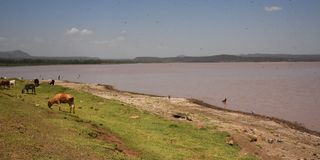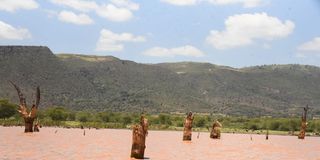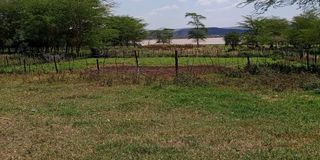How the magnificent Lake Solai was formed

A view of Lake Solai in Rongai.
Nakuru is famously known for its lakes, three of which are Nakuru, Naivasha, and Elementaita.
Mtaa Wangu visited Rongai sub county, where locals got to share insights on how a fourth one, Lake Solai was formed.
According to the residents, where the lake currently lies, was once vast land belonging to the community members who were predominantly pastoralists.
Grace Kipng’ok tells us that her family has lived in lower Solai for more than three decades and that livestock keeping and farming was their main source of livelihood.

Grace Kipng'ok a resident of Solai in Rongai.
She speaks of how the lake grew from originally being a swamp.
Grace says, “Back in 1961, the area occupied by the lake was a small swamp. We used to graze our animals there."
However, she reveals that the little swamp, which would sometimes dry up during the drought season, started swelling up each time it rained, increasing its width as years went by.
Arusto sub-location chief, Patrick Kipng’ok says that the lake was not that large until the 2010 El Nino.

Tree stumps submerged in Lake Solai after the lake swelled up due to heavy rains in 2010.
“Though the lake’s history dates back to 1961, it was only until 2010 that the flash floods brought about by El Nino expanded the boundaries of the lake in great length," Patrick says.
The chief sadly reveals that at least 20 households had their land fully submerged, with some being forced to vacate to higher grounds.
He adds that the rest of the families still live here, even though part of their land is submerged under water.
Jennifer Jepchumba, who gives us a tour of her home, says that growing up in lower Solai, she enjoyed herding cattle.

Jennifer Jepchumba a resident of Solai.
She says that her family had at least 30 acres of land. Sadly, nearly half of it is submerged.
“I cannot complain about the lake’s presence since we have now become a fishing community . We had more than 100 herds of cattle. However, we had to sell some since the grazing fields reduced drastically after the lake formed,” she recalls.

Solai residents were forced to reduce their herd after part of their land was submerged by waters from Lake Solai.
She however shares her concerns of the lake expanding and displacing them, in light of news that the El Nino rains may be experienced this year extending to 2024.
Lake Solai has had episodes of drying up and filling up over the years.
For instance, in the 1990s and also recently in 2009, it fully dried up and locals could cross from one side to the other on foot.

Families living near Lake Solai are concerned that the Lake might swell up and displace them.
“Nonetheless, it took one rainy season to fill up in 2010. Our worry is that with the prediction of El Nino rain, our case may turn out like individuals who were forced out of their homes by water, around Lake Nakuru and Lake Naivasha. Our prayer is that the lake does not swell up to the extent of displacing us from our homes, “says Jepchumba.
